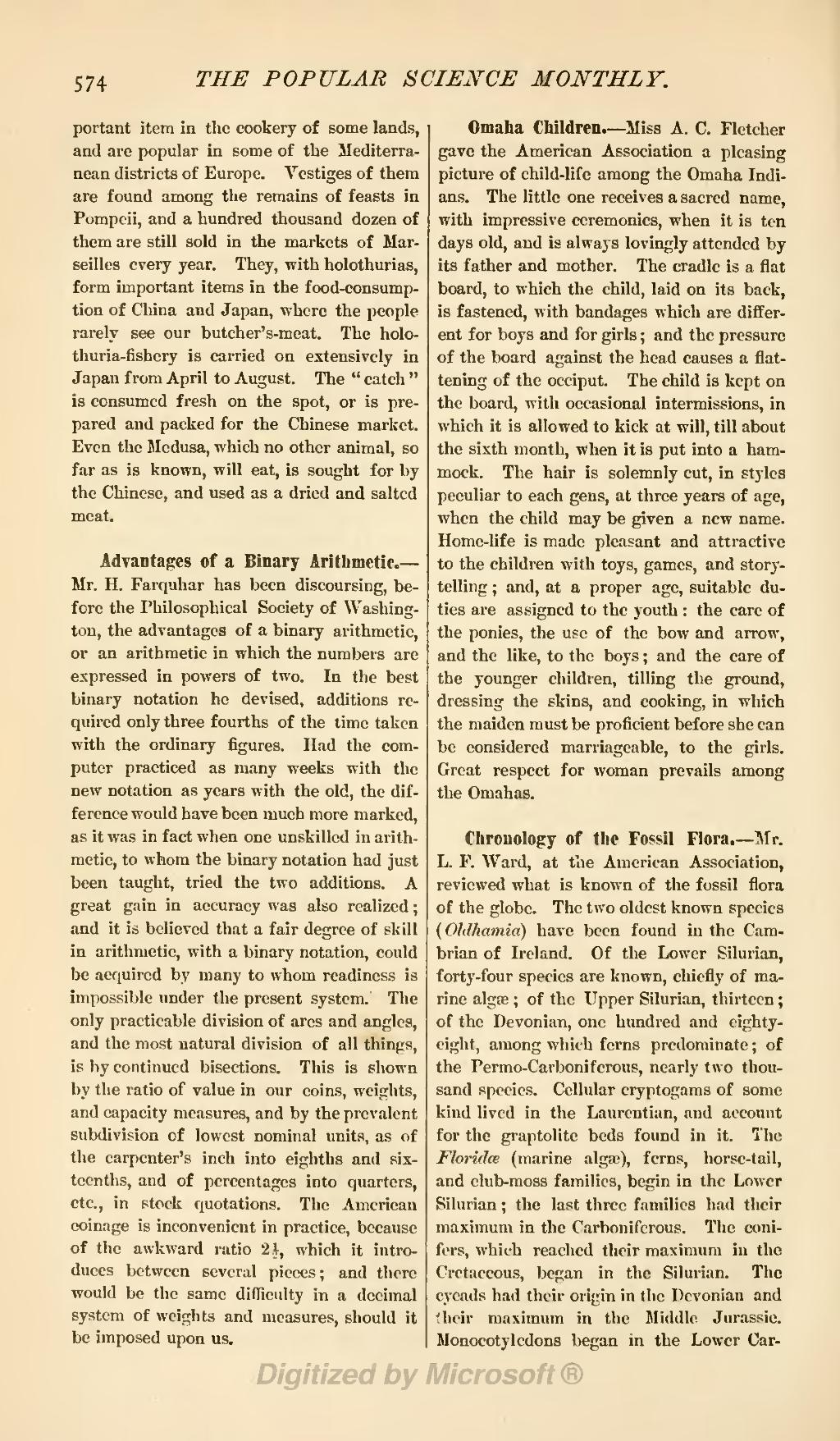portant item in the cookery of some lands, and are popular in some of the Mediterranean districts of Europe. Vestiges of them are found among the remains of feasts in Pompeii, and a hundred thousand dozen of them are still sold in the markets of Marseilles every year. They, with Holothurius, form important items in the food-consumption of China and Japan, where the people rarely see our butcher's-meat. The Holothurius is carried on extensively in Japan from April to August. The "catch" is consumed fresh on the spot, or is prepared and packed for the Chinese market. Even the Medusa, which no other animal, so far as is known, will eat, is sought for by the Chinese, and used as a dried and salted meat.
Advantages of a Binary Arithmetic.—Mr. H. Farquhar has been discoursing, before the Philosophical Society of Washington, the advantages of a binary arithmetic, or an arithmetic in which the numbers are expressed in powers of two. In the best binary notation he devised, additions required only three fourths of the time taken with the ordinary figures. Had the computer practiced as many weeks with the new notation as years with the old, the difference would have been much more marked, as it was in fact when one unskilled in arithmetic, to whom the binary notation had just been taught, tried the two additions. A great gain in accuracy was also realized; and it is believed that a fair degree of skill in arithmetic, with a binary notation, could be acquired by many to whom readiness is impossible under the present system.' The only practicable division of arcs and angles, and the most natural division of all things, is by continued bisections. This is shown by the ratio of value in our coins, weights, and capacity measures, and by the prevalent subdivision of lowest nominal units, as of the carpenter's inch into eighths and sixteenths, and of percentages into quarters, etc., in stock quotations. The American coinage is inconvenient in practice, because of the awkward ratio 212, which it introduces between several pieces; and there would be the same difficulty in a decimal system of weights and measures, should it be imposed upon us.
Omaha Children.—Miss A. C. Fletcher gave the American Association a pleasing picture of child-life among the Omaha Indians. The little one receives a sacred name, with impressive ceremonies, when it is ten days old, and is always lovingly attended by its father and mother. The cradle is a flat board, to which the child, laid on its back, is fastened, with bandages which are different for boys and for girls; and the pressure of the board against the head causes a flattening of the occiput. The child is kept on the board, with occasional intermissions, in which it is allowed to kick at will, till about the sixth month, when it is put into a hammock. The hair is solemnly cut, in styles peculiar to each gens, at three years of age, when the child may be given a new name. Home-life is made pleasant and attractive to the children with toys, games, and storytelling; and, at a proper age, suitable duties are assigned to the youth: the care of the ponies, the use of the bow and arrow, and the like, to the boys; and the care of the younger children, tilling the ground, dressing the skins, and cooking, in which the maiden must be proficient before she can be considered marriageable, to the girls. Great respect for woman prevails among the Omahas.
Chronology of the Fossil Flora.—Mr. L. F. Ward, at the American Association, reviewed what is known of the fossil flora of the globe. The two oldest known species (Oldhamia) have been found in the Cambrian of Ireland. Of the Lower Silurian, forty-four species are known, chiefly of marine algæ; of the Upper Silurian, thirteen; of the Devonian, one hundred and eighty-eight, among which ferns predominate; of the Permo-Carboniferous, nearly two thousand species. Cellular cryptogams of some kind lived in the Laurentian, and account for the graptolite beds found in it. The Florida (marine algæ), ferns, horse-tail, and club-moss families, begin in the Lower Silurian; the last three families had their maximum in the Carboniferous. The conifers, which reached their maximum in the Cretaceous, began in the Silurian. The cycads had their origin in the Devonian and their maximum in the Middle Jurassic. Monocotyledons began in the Lower Car-
